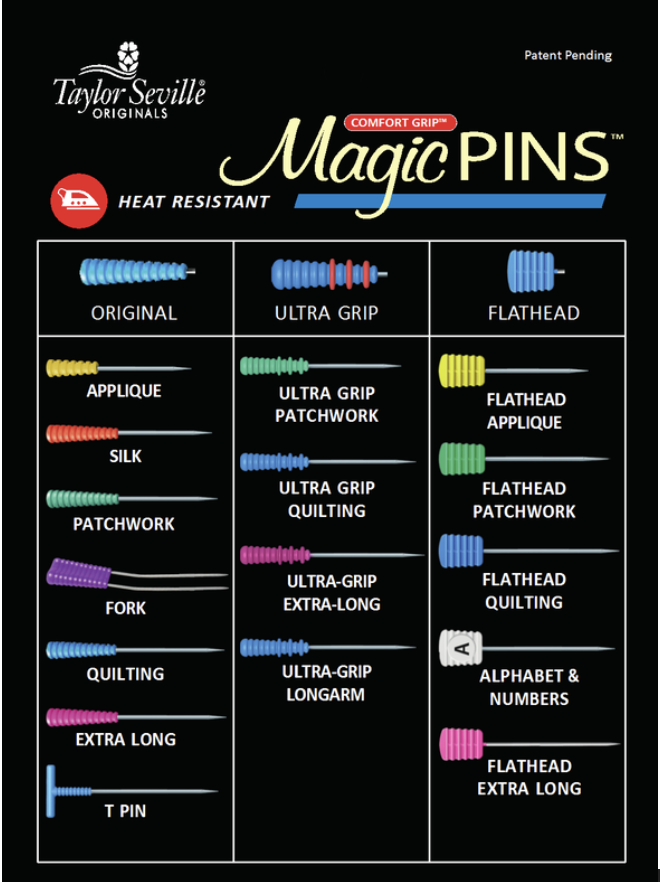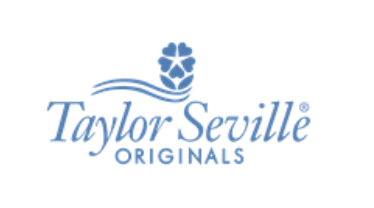Finding The Best Products – Taylor Seville Magic
By Debbie NC Stitches [Updated]
Our Very Short History of Pins
The year is 1838. You’re a quiltmaker in Birmingham, Connecticut. John Howe has just moved his fancy machines to your town and has begun making sewing pins in his new factory. These mass-produced pins are much better than the old handmade iron pins you’ve been using which keep rusting. It would be nice if someone could make pins with different thicknesses and lengths for the different fabrics you use for your quilts. If only there was a better way…..
![]() Fast forward to 2024. Now there is a better way…….
Fast forward to 2024. Now there is a better way…….
Who knew there were so many choices for sewing pins in 2024? For years, only one type of pin was in my sewing room. Once I discovered that there was more than just one category of pin, my projects came together quickly and looked more professional.
Remember, your completed projects are only as good as your tools.
Taylor Seville’s Magic Pins™
Taylor Seville manufactures a wide selection of Magic Pins™ with a super sharp point, a sturdy shaft, and a heat-resistant head. The pin heads are color-coded so you can quickly grab the correct pin.
All Taylor Seville Magic Pins™ have two features in common:
- Heat Resistant Heads. This is an excellent feature when ironing with pins in place—no need to worry about the hot iron accidentally melting the plastic heads.
- Comfort Grip. The pin head is a silicon handle with ridges that create a comfortable grip. These features are specifically designed to alleviate hand fatigue. I found the Comfort Grip pinhead to be much easier on my arthritic hands when sewing for extended periods.
We tested 7 of Taylor Seville’s 19 categories of Magic Pins™ which are sold in containers of either 50 pins or 100 pins. (testing results are in italics below).
- Quilting Pins – Blue comfort grip. Quilting Pins are thicker than Patchwork Pins. Quilting Pins are 1 ¾” long. Easily pins through 8 layers of fabric. The fine Quilting Pin should be used for lightweight fabrics. Regular quilting pins should be used for heavier fabrics. I prefer longer pins for my general sewing.
- Patchwork Extra Fine Pins – Green comfort grip. These pins are thinner than Quilting Pins. This pin is an excellent choice for delicate fabrics. Patchwork pins are 1 ½” long. Patchwork pins have flat heads and are very flexible. Flat pin heads are good for machine embroidery edge-to-edge quilting. I prefer longer pins for most of my sewing.
- Longarm Quilting Pins – Blue comfort grip. The 2 3/8” sharp pins can hold multiple layers of fabric together. Longarm Pins have a long shaft perfect for longarm quilting but not regular sewing.
- Extra Long Pins – Pink comfort grip. This pin is 2 ¼” long and comes in two thicknesses. There they make regular thickness for medium-weight fabric and fine thickness for delicate fabrics or lightweight cotton. (I use fine pins when sewing batik fabrics). Extra Long Pins are very sharp. The long shaft can easily pin 8 layers of fabric. However, with the finer shaft, the longer shaft might be easier to bend if too much pressure is used.
- Silk Pins – Orange comfort grip. These extra-fine pins are shorter and thinner than dressmaker pins. This makes them the perfect choice for thin fabrics like silk. These pins are 1 ½” long. The Silk pins have a short shaft but are very sharp, ideal for silk or cotton.
- Fork Pins – Purple comfort grip. Using a Fork Pin is equivalent to having two pins side by side. These pins are great for keeping seams flat or matching fabric patterns (like plaids). The Fork Pins easily pinned 8 layers of fabric and held a ¼” pressed seam nicely in place. These pins are very sharp. When we tested the fork pins on 2 layers of plaid flannel, all the layers sewed together perfectly, matching the fabric’s pattern.
- Applique Pins – Yellow comfort grip. These are the shortest pins, well designed to secure appliques while stitching them in place. Applique Pins are very sharp. This is important because the sharpness of the pin will hold the applique in place without getting in the way of sewing the applique’s edges. However, the applique pin would not be my choice for regular sewing.
Regardless of which pin you choose, Taylor Seville’s Magic Pins™ provide a great tool to take your creativity to the next level.
******
Taylor Seville Magic 2-in-1 Awl & Seam Ripper™
This tool also includes a Taylor Seville Awl.
Features of the Magic Awl & Seam Ripper™:
- 2 tools in one (a seam ripper and awl)
- Comfort Grip Ergonomic Handle
- Retractable awl and seam ripper
- Can be safely retracted and stored in the handle
- Awl has a durable metal shaft with a sharp, pointed tip








